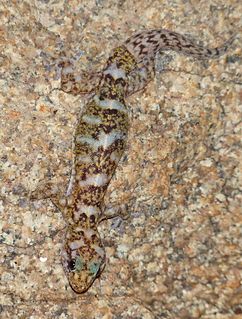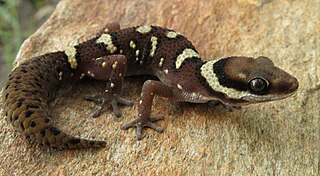
Afroedura is a genus of African geckos, lizards in the family Gekkonidae. Member species are collectively known as rock geckos or flat geckos.

Pachydactylus is a genus of insectivorous geckos, lizards in the family Gekkonidae. The genus is endemic to Africa, and member species are commonly known as thick-toed geckos.

The genus Cordylus includes a wide variety of small- to medium-sized spiny lizards from Africa, collectively called girdle-tailed or girdled lizards. All are diurnal and ovoviviparous. Most species are rupicolous (rock-dwelling), while a few species are arboreal or live in burrows. They defend themselves with osteoderms and by quickly retreating into rock crevices or burrows. Many species live in groups and males defend territories.

Pseudocordylus is a genus of small to large girdled lizards from South Africa, commonly known as crag lizards. Six species of Pseudocordylus are known; they are distinguished from girdled lizards of the genus Cordylus by the presence of granular scales on the back instead of osteoderms. However, recent molecular data places Pseudocordylus within Cordylus.
Acontias is a genus of limbless skinks, the lance skinks, in the African subfamily Acontinae. Most are small animals, but the largest member of the genus is Acontias plumbeus at approximately 40 cm (16 in) snout-vent length. All members of this genus are live-bearing sandswimmers, with fused eyelids. A recent review moved species that were formerly placed in the genera Typhlosaurus, Acontophiops, and Microacontias into this genus, as together these form a single branch in the tree of life. This new concept of Acontias is a sister lineage to Typhlosaurus, and these two genera are the only genera within the subfamily Acontinae.

Holaspis is a genus of equatorial African lizards in the family Lacertidae. These lizards are capable of gliding flight for distances of 30 meters.

Ophisops elegans, commonly known as the snake-eyed lizard, is a species of lizard in the family Lacertidae. The species is endemic to the Mediterranean region and Central Asia. There are nine recognized subspecies.

Psammophis is a genus of snakes in the family Lamprophiidae. The genus comprises 34 species, which are found in Africa and Asia. Psammophis are diurnal and prey on lizards and rodents which they actively hunt. All species in the genus are venomous, and the venom is considered mild and not dangerous to humans.
Atractaspis aterrima, commonly known as the slender burrowing asp or mole viper, is a species of fossorial, venomous snake in the family Atractaspididae. The specific epithet, aterrima, meaning "blackest", is the superlative form of the Latin adjective ater, meaning "black".
Xenocalamus bicolor, or the slender quill-snouted snake, is a species of venomous rear-fanged snake in the family Lamprophiidae. The species is endemic to Africa. Six subspecies are recognized as being valid.
Vivian Frederick Maynard FitzSimons, born in Pietermaritzburg, was a notable herpetologist in South Africa. Also, he contributed to the collection of spermatophyte samples for the National Herbarium which has become part of the South African National Biodiversity Institute at the Pretoria National Botanical Garden. In 1937, together with Anna Amelia Obermeyer, he collected some of the earliest plant specimens from the Eastern Highlands of Rhodesia.
Monopeltis is a genus of amphisbaenians in the family Amphisbaenidae. Species in the genus are commonly known as worm lizards, even though they are not lizards. The genus is endemic to southern Africa. 19 species are placed in this genus.
The Mbanja worm lizard, also known commonly as Ewerbeck's round-headed worm lizard, is a species of amphisbaenian in the family Amphisbaenidae. The species is endemic to Tanzania. There are two recognized subspecies.

Lang's worm lizard is a species of amphisbaenian in the family Amphisbaenidae. The species is native to Southern Africa. There are two recognized subspecies.
Swynnerton's worm lizard, also known commonly as Swynnerton's round-headed worm lizard, is a species of amphisbaenian in the family Amphisbaenidae. The species is native to eastern Africa and southern Africa.

Monopeltis anchietae, also known commonly as Anchieta's worm lizard, Anchieta's spade-snouted worm lizard, and the Angolan spade-snouted worm lizard, is a species of amphisbaenian in the family Amphisbaenidae. The species is native to southern Africa.
Monopeltis sphenorhynchus, also known commonly as Maurice's slender worm lizard, Maurice's spade-snouted worm lizard, and the slender spade-snouted worm lizard, is a species of amphisbaenian in the family Amphisbaenidae. The species is native to southern Africa. There are two recognized subspecies.
Van Dam’s dwarf worm lizard, also known commonly as the sand-dwelling dwarf worm lizard and Van Dam's round-headed worm lizard, is a species of amphisbaenian in the family Amphisbaenidae. The species is native to southern Africa. There are two recognized subspecies.









